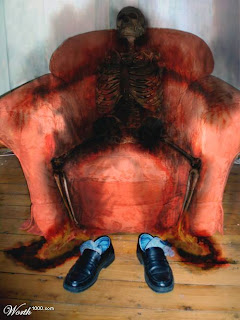There are many mentions of something like SHC in medieval literature. One such instance is the combustion of a knight named Polonus Vorstius sometime during the reign of Queen Bona Sforza in Milan (sometime between 1515 and 1557) [2] In the Sixteenth Century, the Academic Senate of Copenhagen was sent a deposition about a person who died after belching flames, and then being consumed from the inside. (Historiarum Anatomicarum Rariorum by Thomas Bartholin).
Another case in the 17th Century was that of an elderly woman who was found burned to death in north Essex, England. Although the heat must have been intense, nothing else in the cottage (not so much as the bedclothes on which she lay) were even scorched. “No man knoweth what this doth portend” one observer was recorded as saying, hinting darkly at Divine Retribution. In 1731, an account was published about the remains of the Countess Cornelia di Bandi of Cesena, Italy, which were found on the floor of her bedroom. Her body was allegedly ashes but her stockinged legs remained, as did a large portion of her head. However, the first generally accepted claim dates from 1763 when Jonas Dupont compiled a casebook of SHC cases in a book called De Incendiis Corporis Humani Spontaneis, having been compelled by the Nicole Millet case.
In 1861, George Henry Lewes published a sequence of letters between him and Charles Dickens, in which Lewes chided Dickens for propagating the ‘myth’ of SHC in his novel Bleak House: “In these accounts it is usually stated that the body entirely disappears down to a greasy stain on the floor and some remains of bones. Everyone knows this to be impossible.” Dickens added his own response to the second edition of Bleak House, referring to the case of a German liquor-shop owner in Columbus, Ohio who mysteriously burst into flames in 1853.
In 1870[4], the Assistant Professor of Medical Jurisprudence at the University of Aberdeen published a paper entitled On Spontaneous Combustion. In it, he wrote that he had found 54 contemporary scientists who had written on the subject of SHC. Of these, 35 expressed definite opinions on the validity of the alleged phenomenon:
Five of these (including Liebig) were entirely skeptical.
Three (including Dupuytren) believed that SHC was best accounted for in terms of preternatural combustion (broadly speaking, misidentification theory, discussed below).
Twenty-seven (including Devergie and Orfila) stated their definite belief in the spontaneous ignitability of the human body.
In the late 1950s, a 19-year-old secretary, dancing with her boyfriend in a London discotheque, was recorded as suddenly bursting into flames. As though driven by an inner storm, fire burst furiously from her back and chest, enveloping her head and igniting her hair, turning her in seconds to a human torch, and was dead before her horrified companion and other people on the dance floor could beat out the flames. Her boyfriend testified at the inquest: “I saw no one smoking on the dance floor. There were no candles on the tables and I did not see her dress catch fire from anything. I know it sounds incredible, but it appeared to me that the flames burst outwards, as if they originated within her body”. Other witnesses agreed with him, and the coroner’s verdict was eventually ‘Death by misadventure, caused by a fire of unknown origin’.
More recently, an English building contractor was driving past one of his construction sites and waved through the car window; a moment later, he allegedly simply burst into flames.[citation needed] Similarly, a man from Cheshire, in the north of England, was found totally incinerated in the cab of his truck. The London Daily Telegraph reported: “Police witnesses testified they had found the petrol(gasoline) tank full and unharmed by fire, the doors of the cab opened easily, but the interior was a ‘veritable furnace’. The coroner’s jury declared they were unable to determine how the incident occurred.” Reynold’s News, a few years later, recorded the tragic death of a west London man who, while walking along the street, ‘appeared to explode. His clothes burned fiercely, his hair was burned off, and the rubber-soled boots melted on his feet’.
More on SHC: http://en.wikipedia.org/wiki/Spontaneous_human_combustion
Video: http://misteryo.multiply.com/video/item/74
